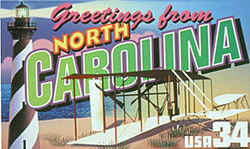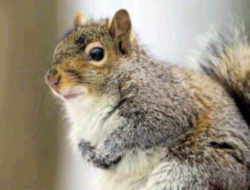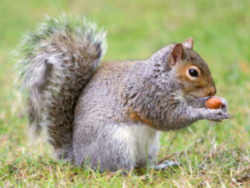
North Carolina Symbols
North Carolina Mammal
Gray Squirrel

(Sciurus carolinensis)
Adopted in 1969.
The NC General Assembly of 1969 named the Gray Squirrel, (Sciurus carolinensis,) as North Carolina official State Mammal (Session Laws, 1969, c. 1207).
The bill was introduced by Rep. Basil Barr of Ashe County, who conducted a survey of school children to determine a favorite. Having noted that North Carolina already had an official bird, tree, flower, and shell, Barr proposed the squirrel as a state symbol, characterizing it as "courageous and thrifty"(quoted in the Statesville Record and Landmark, June 4, 1969, sec. 2 p. 1). The bill was introduced in the House on May 29th, passed a week later, and went on to the Senate, which approved it on June 30.
North Carolina State Mammal: Gray Squirrel

The gray squirrel is a common inhabitant of most areas of North Carolina from "the swamps of eastern North Carolina to the upland hardwood forests of the piedmont and western counties." It was adopted in 1969 as the North Carolina Mammal. He feels more at home in an "untouched wilderness" environment, although many squirrels inhabit our city parks and suburbs. During the fall and winter months the gray squirrel survives on a diet of hardwoods, with acorns providing carbohydrates and proteins. In the spring and summer, their diet consists of "new growth and fruits" supplemented by early corn, peanuts, and insects.
First described in 1788, the squirrel contributed in its own small way to the survival of the North American colonies and the success of the Revolution. As an abundant game animal it provided a much needed food source, and some early chronicles suggested that the marksmanship necessary to successfully hunt such an elusive animal was a vital training ground for the citizen-soldiers who fought in the American Revolution and the War of 1812.
The squirrel is diurnal (that is, active during the day), and largely arboreal. Dens are in natural tree hollows or dreys (nests) made of twigs and branches. Being both adaptable and omnivorous, squirrels can flourish in hardwood forests, suburban woodlands, small parks, and even urban neighborhoods with shade trees.
The gray squirrel may be found in all 100 counties of the state. Its range extends from Florida to southern Canada, and west as far as the Great Plains. Though their diet consists mostly of nuts and seeds, gray squirrels will also eat tree buds, bark, fruit, fungi, insects, eggs, and occasionally even small birds. During the autumn, squirrels will "scatter hoard"nuts (that is, bury them in multiple locations as a food source for the winter), thus not only creating their own food cache, but also providing an ongoing means of reforestation, since many of the nuts they bury remain uneaten, and so have a chance to germinate.
Gray Squirrel
A medium-sized squirrel with upperparts dark yellowish rusty, especially on head and back; legs, arms, sides of neck, and sides of rump with gray-tipped or white-tipped hairs, giving a gray tone to these parts; hairs of tail dull yellow at base, then blackish, and tipped with white; underparts white; ears with conspicuous white spot at base in winter. External measurements average: total length, 460 mm; tail, 210 mm; hind foot, 61 mm. Weight of adults, 321-590 g.
Other things to look for: A tree-dweller with a very bushy tail. In the summer months, one sometimes may see a Gray Squirrel which looks hairless. This condition is caused by a mite infestation called mange.
Natural History
The Gray Squirrel prefers hardwood forests of the Piedmont Region, mountains, and river and stream floodplains where an abundant supply of nuts, acorns, fruits, and flowers can be found. It will also eat insects and occasionally bird eggs. The Gray Squirrel constructs two types of nests. One is in a tree cavity, and is used for rearing young and for winter shelter. The other type of nest, which looks like a ball of dry leaves and twigs lined with plant fibers, is lodged in the upper branches of a tree. It is used as temporary shelter in both summer and winter. Main predators of the Gray Squirrel include hawks, owls, the Coyote, foxes, the Bobcat, and occasionally weasels, raccoons, and snakes. Wild individuals have an average life expectancy of 5 years.
North Carolina Session Laws, 1969, c. 1207:
H. B. 1268; CHAPTER 1207
AN ACT TO ADOPT AN OFFICIAL STATE MAMMAL FOR THE STATE OF NORTH CAROLINA.
The General Assembly of North Carolina do enact:
Section 1. The Gray Squirrel (Sciurus carolinensis) is hereby adopted as the official State mammal of the State of North Carolina.
Sec. 2. All laws and clauses of laws in conflict with this Act are hereby repealed.
Sec. 3. This Act shall be in full force and effect from and after its ratification.
In the General Assembly read three times and ratified, this the 1st day of July, 1969.
North Carolina Law
The law designating the gray squirrel as the official North Carolina state mammal is found in the The North Carolina General Statutes, Chapter 145, Section 145-5.
Chapter 145.
State Symbols and Other Official Adoptions.
§ 145-5. State mammal.
The gray squirrel (Sciurus carolinensis) is hereby adopted as the official State mammal of the State of North Carolina.
(1969, c. 1207.)
Taxonomic Hierarchy: Gray Squirrel
Kingdom: Animalia
Phylum: Chordata
Class: Mammalia
Order: Rodentia
Family: Sciuridae
Genus: Sciurus
Subgenus: Sciurus
Species: S. carolinensis - Gmelin, 1788
Subspecies: S. c. carolinensis; S. c. extimus; S. c. fuliginosus; S. c. hypophaeus; S. c. pennsylvanicus







